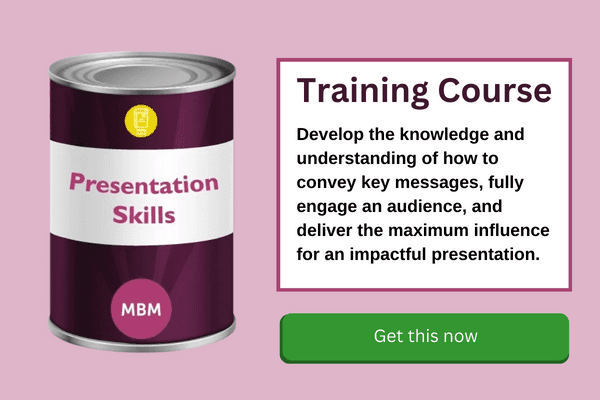Key Presentation Skills
A presentation, in our definition, is a kind of communication that may be customised for different speaking contexts, such as addressing a group, leading a meeting, or briefing a team. Effective presentations typically need thorough planning and preparation, yet it doesn’t have to take much time. So allow us to aid you with some presentation skills examples.
In order to properly convey your message, clear and effective data presentation is a crucial skill. Nearly all fields nowadays demand presenting abilities, and the majority of us occasionally have to deliver presentations. While some people are able to handle this with ease, others find it to be much harder.
But with a little effort, you can develop your presentation skills. In order to have an outstanding presentation, you need to first know and master the medium of such presentation. The context and subject of your presentation will determine which medium is best for you. Of course, there are also your own preferences.

Now, What are Good Presentation Skills Examples?
Whether you are presenting to an individual or a group, be it a formal or informal setting, we can all agree that there are certain presentation skills that one should have. This article will take a look at various techniques of presentation skills with examples, how to harness them and be better prepared for your next presentation.
#1: Your Voice is Your Greatest Asset
The first of our presentation skills examples focuses on your voice. Nobody wants to sit and listen to a speaker who is not audible enough or does not sound confident in himself or what they are speaking about. Learning to control your vocals is important. Knowing what words to stress and when to stress them is also important, which is why practice is non-negotiable.
This helps you know when to raise your voice, which creates anticipation and gets the attention of the audience, and when to not, which creates suspense too. You need to emphasize the words that you want to catch your audience’s attention. It is critical to know these so as to know how to strike a balance in your tone of presentation.
It is naturally challenging to feel less confident when presenting in a language that you do not really speak fluently. So that everyone who hears you speak can benefit from your expertise and knowledge, get some assistance speaking properly in English (or whatever language you are presenting in).

In a fully oral presentation, for example, your audience will be banking on hearing what you have to say and how well you can make them listen to you. So make it worthwhile.
Tip: Your voice is your greatest asset, knowing how to use it can determine the outcome of your presentation. Before you begin your presentation, make the sound “hm” (like you’re agreeing with someone). It helps to calm your nerves and prepare you.
#2: Data Visualisation
Using data in a presentation can often significantly improve the way you convey the story. But you must be careful not to overwhelm your audience with numbers.
Infographics play a big role in presentations. There is a reason why it is said that a picture is worth a thousand words: they may help you make your point, keep your audience interested, and help you remember what you were trying to convey. Additionally, keep in mind that many people find it challenging to comprehend numbers, so consider adding charts, icons, and graphs and creating infographics, like in this example below.
Tip: For an effective presentation, you need to use data and visuals, this way your information is presented to your audience in a most appealing way.
#3: Body Language
You can exude confidence not only in your voice, but also in your body language. Remember, you are the expert in this situation, so act as such throughout the presentation. Keep in mind that everyone is anxious!
When presenting, one of the first things to think about is how you use your face and hands. Always look at each of your participants and maintain eye contact. While you shouldn’t fix your eyes on them, try to appear as though you are speaking to everyone in the room.
Your audience normally includes one or possibly a few more folks who are simple to present to. They frequently nod in agreement or smile while looking at you. It is easy to just “talk” to the audience by staring at them constantly.
You won’t be able to connect with others or convince them to agree with you when you offer your thoughts if all you do is keep staring at and talking to this particular set of people. Therefore, be careful that you aren’t only looking at and talking to one or two really appreciative audience members. That way, each member of the audience feels special and spoken to.
Tip: Remember to smile. Smiling eases tension, fosters a positive environment, and conveys that you are having fun. Also, practice is the key to knowing your body language and using it effectively during a presentation.
#4: Connect With Your Audience

This is perhaps one of the harder of these presentation skills examples, as connecting with people takes time. One great way to connect with your audience is to use storytelling, humour, anecdotes and ask questions. Keep them engaged, so much that whoever was not listening would ask someone next to them what you said, and those that were listening would want to listen even more. Make a compelling presentation and include some interesting or amusing facts.
Connecting with your audience could also be as simple as asking a question and picking someone randomly to answer it. That way, you not only have their attention, but you also show that you care about them and want them involved in the presentation.
Avoid remaining motionless throughout the presentation by moving around occasionally. To keep the crowd engaged and the energy high, move around a little on stage. You can also use your hands and arms to make small movements, watch how the audience responds to these gestures and use it to keep them engaged.
Tip: Look around the room before beginning a presentation so you know where to move to. This ensures that you do not break eye contact with your audience, which catches their attention and keeps their focus on you.
#5: The Power of PowerPoint Slides
Don’t read your slides word for word. It shows incompetence and lack of preparedness, and you don’t want your audience to think that way. Never simply read what is on a slide in a PowerPoint presentation by clicking from slide to slide.
Know your material, add notes or additional information while the slide is displayed, and face the audience the majority of the time. It gives you control of the presentation and the room.
Creative backgrounds with colours that match your brand in each PowerPoint slide will make your presentation interesting. Also, a maximum of 4 to 5 key points is enough in one slide. The audience won’t pay any attention to you and the additional information you have if there are too many points on the slide. This is because they will be preoccupied attempting to read them all.
Most examples of oral presentations in the workplace require PowerPoint slides, to present and analyze data and information. Therefore, use your slides to present data, quotes and icons to reinforce your message, like in this presentation template.
Also, avoid using too many gimmicks on your slides; such as having a lot of words or images flash over the screen or having things appear randomly. A little keeps things intriguing, but a lot diverts attention away from your main point. Remember, you want your audience to focus on you and listen to you.
Tip: If you can, research and understand the people you will be presenting to, and think of a story that they all can relate to or have experienced. It helps them connect better with your presentation.
#6: Create a Lasting First Impression
The success of your entire presentation anchors on the impression you create in the first few seconds of your presentation. It is very easy to become anxious and get sucked into the crowd and lose composure for the first 5 to 10 seconds, it can happen to anybody.
Breathe, and keep in mind that speaking more slowly in order to be understood is acceptable when we are frightened. Also, say something interesting or ask a question that will keep your audience glued to their seats, making them want to listen to you speak.
Pressure and the waiting audience can be quite overwhelming, but don’t forget to breathe.
Tip: Before you begin your presentation, strike the ‘superman pose’ to make you feel calm and in control. It influences our hormones, lessening levels of cortisol and boosting testosterone production. Plant your feet, don’t move back and forth in the same spot.
#7: Elocution and Filler Words

As a beginner or even a medium expert presenter, it is easy to often use filler words. It sometimes portrays nervousness or anxiety, and we try to use that to calm ourselves or remember our lines. Filler words are not entirely bad, even the best speakers use them. It becomes bad when you use too many of them.
For the sake of clarity, a few examples of filler words are: ‘ah’, ‘err’, ‘ok’, ‘like’, ‘er’, ‘um’. It is usually not easy to not use them at first, but with practice and intentionality, it gets better. Asides from constantly practising, you can also record yourself speaking, play it back and watch out for fillers.
Another trick is to pause. It helps you catch your breath and automatically avoid the filler that might be lodged somewhere in your mouth. This trick might want to make you rush your sentence, but you also want to watch out for that.
Avoiding the usage of fillers does not mean you should rush your presentation or be slow. Rather, it is so you get your thoughts together and do not appear like you don’t know what you are saying or are struggling to recollect your presentation.
Using fillers can be quite disturbing to your audience. Put an end to your sentences, take a breath, and then begin again.
Tip: Don’t be afraid to communicate informally. Naturally, you wish to appear professional, but you also want to sound friendly and open.
#8: Topical Knowledge
It is very important to have in-depth knowledge of the topic you will be presenting, this way you do not miss facts and figures and you are ready for questions that your audience might ask you. It also shows your dedication to the task and the presentation.
The first step in effective preparation is selecting a topic that is clear and concise. Adjust the scope of your subject to the time allotted for your presentation so that you may cover all the essential information without feeling rushed.
After deciding on a topic, you can then begin conducting in-depth research. You build the general framework using the data that has been gathered. Make sure your structure is consistent and logical.
#9: Clarity and Structure
The last of our presentation skills examples is about clarity. Let your presentation be straightforward and concise. Information and data should flow appropriately and the next slide should corroborate what was in the last slide, as well as enhance what is expected in the next one.
Your presentation needs an opening, a body, and a conclusion. Everything must make sense and be connected.
It is also essential to prepare and practice for your presentation. The secret is to plan. Researching, creating the slides, and creating the text is vital, but so is practising the entire presentation in front of a mirror or someone else, to get their reaction and judge your performance.
Conclusion
In the business world, presentations form a huge part of how most work gets done. Getting your presentation skills right is the first step to acing your presentation.
One more thing, don’t overrun your time, try to stick to a schedule and fit all that you have to say into the time you were given. Also, your audience is there to listen to you and make their time worth it. Getting your facts right and together in one place will prevent rambling and having practised over and over again, the process becomes easier for you.
When you finish, if you can, record your presentation or get a tape of the recording and watch it. This is to help you know what you did right and did not particularly get right. This is in preparation for your next presentation, which you should do better than the last.
As a manager who wants the best for his or her employees, mentioning their presentation skills in appraisal comments will go a long way in encouraging them to do better and letting them know their work is not going unnoticed. Also, leading a goal-setting presentation for employees could help teach them some effective presentation techniques.
Action: If you enjoyed this article on Presentation Skills Examples, you’ll enjoy our ultimate guide on presentation skills.




